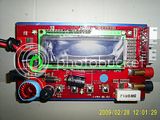I went a bit too far and let the magic smoke out the IMAx B5.
This is how I connected it when it fried:
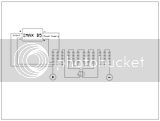
Before frying it, I wrote this draft but did not post it:
I've opened the IMAX B5 charger up and had a look and did a few resistance measurements.
There seems to be a resistance of 10MOhm between the input leads and the output leads. But I did a few weeks ago measure that there was the full voltage between the negative input lead (plugged into a tab of the 102 cell string) and any other cell in that 102 cell string. There was also a spark when I first tried to connect one of the two output cables to the tab of the cell I wanted to charge.
The IMAX B5 PCB is way too complex for me to understand. It has a top and a bottom layer, and loads of very small components. Additionally, many parts cannot be inspected easily because the LCD display has been mounted over the top of the smaller components at the end of assembly.
My guess is that the spark was caused by a discharging capacitor, and that the current flow after that initial spark would have been negligible, apart from the actual charging current once the charger is starting to charge.
I'll try to take some more measurements later on. Maybe measure the current flow between output leads and 102 cell string tabs through a resistor; that should show if the sparking is a temporary current or a true short circuit.
I did make more measurements instead of posting the above: The resistance values kept changing, depending on polarity and duration of connection to various points on the IMAX PCB; due to capacitors, I guess. And the resistance values between power supply cables and output was always in the several MOhm range, usually 8 - 10MOhm.
So I thought it might be safe to try it out....Not So!
Excuse the poor picture quality, please:
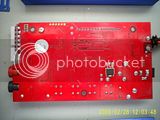
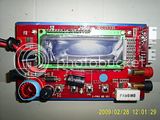
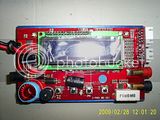
I connected the Input cables to tabs 3 (+) and 11 (-) of the 102 cell string (still counting the wrong way from the positive end up...) and the IMAX fired up as it's supposed to.
I measured voltage between positive and negative output cables and tabs 1 and tab 2: Very close to what it would have been between tab 11 and tab 1 or tab 2.
Then I connected an ammeter, in series with a 5W6k8 resistor, between negative output cable and tab 2: About 0.9mA flowed. Very similar results between the positive charging output and tabs 1 and tab 2. When the negative output cable was connected to either tab 1 or tab 2 the charger would give an error message: "Polarity error"
When the positive cable was connected to either tab 2 or tab 2, then there was no error message.
When the positive cable was already connected to tab 1 , then there was no error message when the negative cable was connected to tab 2. The current flow was still below 1mA, still with the 6k8 resistor in series.
Then I set the IMAX to charge at 1A and pressed start. It announced that it is putting in exactly 1.5A, and at about 12V, into a single cell. The ammeter reported something between 1A and 1.5A. I turned it off and on again. Same result.
The I realised that the 6k8 resistor was still in line (and very hot). I removed it and repeated the 1A test. I got an "Input voltage error", and put the negative input terminal one tab higher up on the cell string to increase the input voltage. When I turned it back on, there was a slight POP and smoke came out of the side of the IMAX.
The small, 8-pin IC that smoldered is circled in green:
